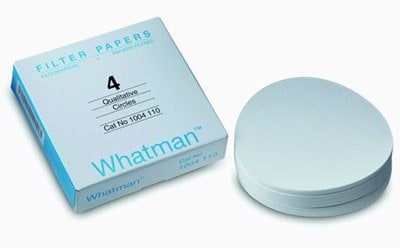Filter Paper

Used commonly in quantitative and qualitative analysis, filter papers must be closely matched to the application according to the physical characteristics of the filter paper. There are many sizes, materials, types, and grades of filter paper available for a variety of applications. Whatman® filter papers use only the highest quality raw materials for high reproducibility and high uniformity. Whatman® cellulose filter papers are manufactured from high-quality cotton liners that are treated to achieve an α-cellulose content >98%. A wide selection of Whatman® filter papers are available to suit numerous laboratory applications. Pre-pleated (folded) filter paper is also available for convenience.
Products
Whatman® Qualitative Filter Paper
Qualitative filter papers are what most users would consider general purpose filter papers, designed for use in analytical separations and qualitative analytical techniques for the determination and identification of particles, contaminants, or material components. Qualitative papers are categorized by paper grades based on various properties including thickness, weight, and particle retention. The most common qualitative paper grades are 1-6, 595, 597, 598, and 602, which have applications across multiple industries.
Whatman® Quantitative Filter Paper
Quantitative filter papers are designed for sample preparation and gravimetric analysis, and are typically selected based upon the level of surface toughness and ash content required for the filtration procedure. Quantitative papers are acid treated to reduce ash, often to less than 0.01%. This low ash content is useful for quantitative analyses. After filtration or sample collection, the filter paper can be ignited and burned off, leaving very little residue that could interfere in downstream measurements.
- Ashless filter paper: 0.007% ash nominal for grades 40 to 44 and a typical of 0.01% for 589 grades; very pure filters suitable for a wide range of critical analytical filtration procedures.
- Hardened low ash filter paper: 0.015% ash nominal; treated with a strong acid to remove trace metals and produce high wet strength and chemical resistance; particularly suitable for Buchner filtration where the tough, smooth surface of the filter makes it easy to recover precipitates.
- Hardened ashless filter paper: 0.005% ash nominal; acid hardened to give high wet strength and chemical resistance with extremely low ash content; tough surface makes these filters suitable for a wide range of critical filtration procedures.
Cytiva™ Blotting and Chromatography Paper
Whatman® 3MM Chr paper is the world’s most widely used blotting paper. A medium thickness paper (0.34 mm) is used extensively in electrophoresis for lifting of sequencing gels and relied upon by researchers doing Southern, Northern, and Western transfers. 3MM Chr paper is now available in the most widely used sizes. GB005 is a thick (1.5 mm) highly absorbent paper recommended for applications where fewer layers of blotting paper must still ensure a high capacity, including semi-dry blotting of proteins. GB003 is a general-purpose blotting paper (0.8 mm) made from pure raw materials with a high absorbency used as a membrane gel support. This thick paper is recommended for the lysis/denaturation of colony or plaque lifts and Western blots.
- Pure cellulose produced entirely from the highest quality cotton linters with no additives of any kind. Ensures that no contamination will occur during transfer steps.
- Manufactured and tested specifically for chromatographic and blotting techniques. This ensures the wicking capability and uniformity of capillary action that are important in obtaining clean and even transfers during blotting.
- Whatman® 3MM Chr is considered the industry standard for blotting procedures.
- Convenient sizes available in sheets precisely cut to the most popular gel and transfer membrane sizes. Allows "out-of-the-box" usage and eliminates sheet-to-sheet variations.
To continue reading please sign in or create an account.
Don't Have An Account?